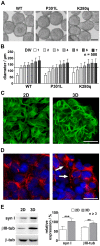Induced tauopathy in a novel 3D-culture model mediates neurodegenerative processes: a real-time study on biochips
- PMID: 23145103
- PMCID: PMC3492324
- DOI: 10.1371/journal.pone.0049150
Induced tauopathy in a novel 3D-culture model mediates neurodegenerative processes: a real-time study on biochips
Abstract
Tauopathies including Alzheimer's disease represent one of the major health problems of aging population worldwide. Therefore, a better understanding of tau-dependent pathologies and consequently, tau-related intervention strategies is highly demanded. In recent years, several tau-focused therapies have been proposed with the aim to stop disease progression. However, to develop efficient active pharmaceutical ingredients for the broad treatment of Alzheimer's disease patients, further improvements are necessary for understanding the detailed neurodegenerative processes as well as the mechanism and side effects of potential active pharmaceutical ingredients (API) in the neuronal system. In this context, there is a lack of suitable complex in vitro cell culture models recapitulating major aspects of taupathological degenerative processes in sufficient time and reproducible manner.Herewith, we describe a novel 3D SH-SY5Y cell-based, tauopathy model that shows advanced characteristics of matured neurons in comparison to monolayer cultures without the need of artificial differentiation promoting agents. Moreover, the recombinant expression of a novel highly pathologic fourfold mutated human tau variant lead to a fast and emphasized degeneration of neuritic processes. The neurodegenerative effects could be analyzed in real time and with high sensitivity using our unique microcavity array-based impedance spectroscopy measurement system. We were able to quantify a time- and concentration-dependent relative impedance decrease when Alzheimer's disease-like tau pathology was induced in the neuronal 3D cell culture model. In combination with the collected optical information, the degenerative processes within each 3D-culture could be monitored and analyzed. More strikingly, tau-specific regenerative effects caused by tau-focused active pharmaceutical ingredients could be quantitatively monitored by impedance spectroscopy.Bringing together our novel complex 3D cell culture taupathology model and our microcavity array-based impedimetric measurement system, we provide a powerful tool for the label-free investigation of tau-related pathology processes as well as the high content analysis of potential active pharmaceutical ingredient candidates.
Conflict of interest statement
Figures





Comment in
-
Neurodegenerative disease: a novel 3D culture model of tauopathy shows promise as a screening tool for Alzheimer disease therapies.Nat Rev Neurol. 2013 Jan;9(1):2. doi: 10.1038/nrneurol.2012.245. Epub 2012 Dec 4. Nat Rev Neurol. 2013. PMID: 23208115 No abstract available.
Similar articles
-
A novel organotypic tauopathy model on a new microcavity chip for bioelectronic label-free and real time monitoring.Biosens Bioelectron. 2010 Sep 15;26(1):162-8. doi: 10.1016/j.bios.2010.06.002. Epub 2010 Jun 9. Biosens Bioelectron. 2010. PMID: 20591644
-
A novel 384-multiwell microelectrode array for the impedimetric monitoring of Tau protein induced neurodegenerative processes.Biosens Bioelectron. 2017 Feb 15;88:78-84. doi: 10.1016/j.bios.2016.07.074. Epub 2016 Jul 25. Biosens Bioelectron. 2017. PMID: 27506337
-
Neuron-selective toxicity of tau peptide in a cell culture model of neurodegenerative tauopathy: essential role for aggregation in neurotoxicity.J Neurosci Res. 2010 Nov 15;88(15):3399-413. doi: 10.1002/jnr.22485. J Neurosci Res. 2010. PMID: 20882568
-
Roles of tau pathology in the locus coeruleus (LC) in age-associated pathophysiology and Alzheimer's disease pathogenesis: Potential strategies to protect the LC against aging.Brain Res. 2019 Jan 1;1702:17-28. doi: 10.1016/j.brainres.2017.12.027. Epub 2017 Dec 21. Brain Res. 2019. PMID: 29274876 Review.
-
Tau alteration and neuronal degeneration in tauopathies: mechanisms and models.Biochim Biophys Acta. 2005 Jan 3;1739(2-3):331-54. doi: 10.1016/j.bbadis.2004.06.018. Biochim Biophys Acta. 2005. PMID: 15615650 Review.
Cited by
-
HS3ST2 expression induces the cell autonomous aggregation of tau.Sci Rep. 2022 Jun 27;12(1):10850. doi: 10.1038/s41598-022-13486-6. Sci Rep. 2022. PMID: 35760982 Free PMC article.
-
Experimental models for identifying modifiers of polyglutamine-induced aggregation and neurodegeneration.Neurotherapeutics. 2013 Jul;10(3):400-15. doi: 10.1007/s13311-013-0195-4. Neurotherapeutics. 2013. PMID: 23700210 Free PMC article.
-
Alzheimer's in 3D culture: challenges and perspectives.Bioessays. 2015 Oct;37(10):1139-48. doi: 10.1002/bies.201500063. Epub 2015 Aug 7. Bioessays. 2015. PMID: 26252541 Free PMC article. Review.
-
Induced pluripotent stem cells: a tool for modeling Parkinson's disease.Trends Neurosci. 2022 Aug;45(8):608-620. doi: 10.1016/j.tins.2022.05.001. Epub 2022 Jun 3. Trends Neurosci. 2022. PMID: 35667922 Free PMC article. Review.
-
Deconstructing Alzheimer's Disease: How to Bridge the Gap between Experimental Models and the Human Pathology?Int J Mol Sci. 2021 Aug 16;22(16):8769. doi: 10.3390/ijms22168769. Int J Mol Sci. 2021. PMID: 34445475 Free PMC article. Review.
References
-
- Rodgers AB (2008) ALZHEIMER’S DISEASE Unraveling the Mystery. In: Aging NIoHNIo, editor. Silver Spring. 79.
-
- Brookmeyer R, Johnson E, Ziegler-Graham K, Arrighi HM (2007) Forecasting the global burden of Alzheimer’s disease. Alzheimers Dement 3: 186–191. - PubMed
-
- Ittner LM, Gotz J (2011) Amyloid-beta and tau–a toxic pas de deux in Alzheimer’s disease. Nat Rev Neurosci 12: 65–72. - PubMed
Publication types
MeSH terms
Substances
LinkOut - more resources
Full Text Sources
Other Literature Sources
Medical

